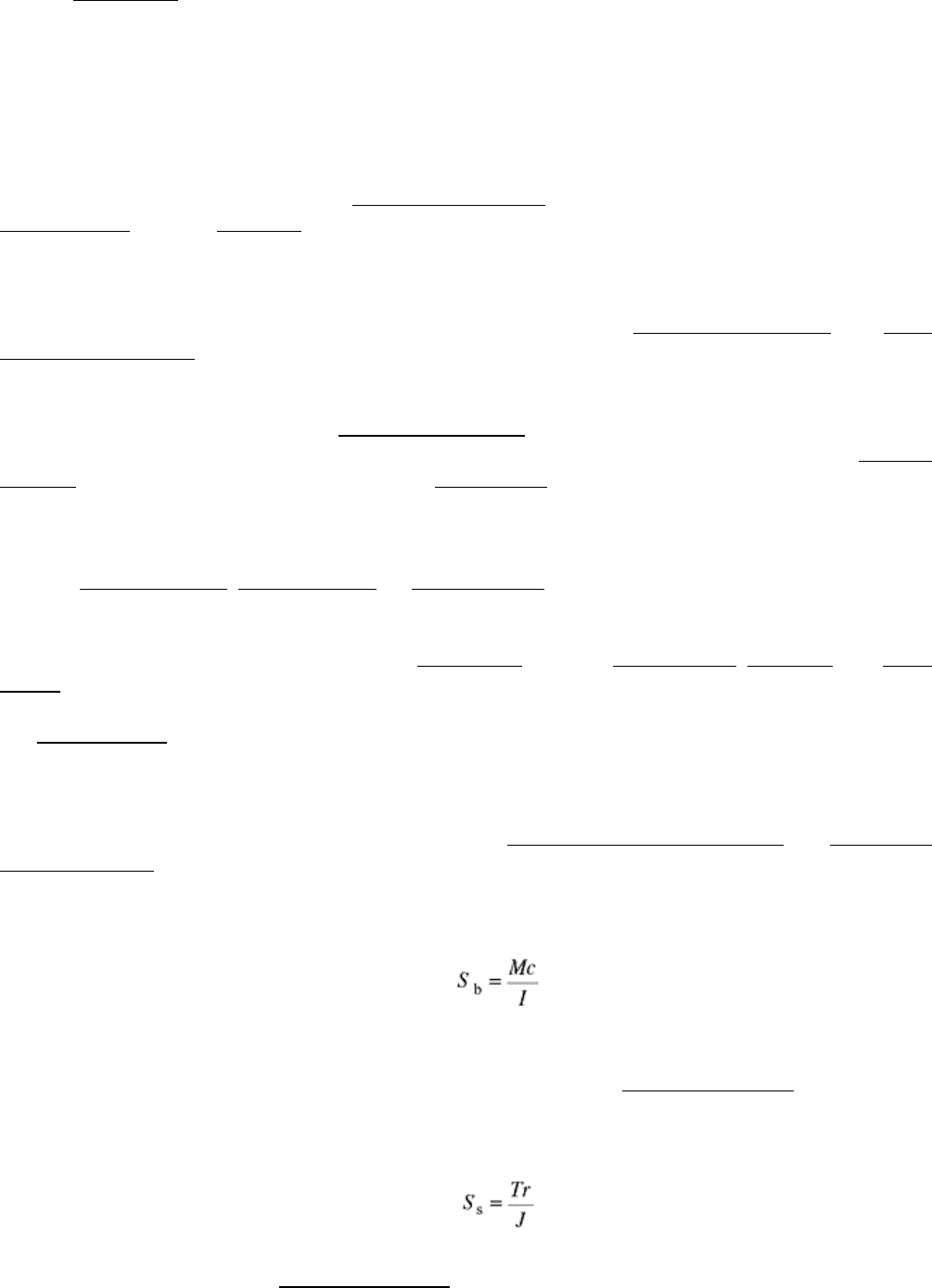ASM Metals HandBook Vol. 8 - Mechanical Testing and Evaluation
Подождите немного. Документ загружается.


The property of a material by virtue of which deformation caused by stress disappears on removal of the
stress. A perfectly elastic body completely recovers its original shape and dimensions after release of
stress.
elongation
A term used in mechanical testing to describe the amount of extension of a test piece when stressed. See
also elongation, percent.
elongation, percent
The extension of a uniform section of a specimen expressed as percentage of the original gage length:
where L
o
is original gage length, and L
x
is final gage length.
endurance
The capacity of a material to withstand repeated application of stress.
endurance limit
The maximum stress below which a material can presumably endure an infinite number of stress cycles.
The value of the maximum stress and the stress ratio also should be stated. Compare with fatigue limit.
engineering strain (e)
A term sometimes used for average linear strain or conventional strain in order to differentiate it from
true strain. In tension testing it is calculated by dividing the change in the gage length by the original
gage length.
engineering stress (s)
A term sometimes used for conventional stress in order to differentiate it from true stress. In tension
testing, it is calculated by dividing the breaking load applied to the specimen by the original cross-
sectional area of the specimen.
environmentally assisted cracking
Brittle fracture of a normally ductile material in which the corrosive effect of the environment is a
causative factor. Environmental cracking is a general term that includes corrosion fatigue, high-
temperature hydrogen attack, hydrogen blistering, hydrogen embrittlement, liquid metal embrittlement,
solid metal embrittlement, stress-corrosion cracking, and sulfide stress cracking.
equiaxed grain structure
A structure in which the grains have approximately the same dimensions in all directions.
Erichsen cup test
A cupping test used for assessing the ductility of sheet metal. The method consists of forcing a conical
or hemispherical-ended plunger into the specimen and measuring the depth of the impression at fracture.
Compare with Olsen cup test and Swift cup test.
erosion
Progressive loss of original material from a solid surface due to mechanical interaction between that
surface and a fluid, a multicomponent fluid, or impinging liquid or solid particles.
error
Deviation from the correct value. For a testing machine, the difference obtained by subtracting the load
indicated by the calibration device from the load indicated by the testing machine.
extensometer
An instrument for measuring changes in length over a given gage length caused by application or
removal of a force. Commonly used in tension testing of metal specimens.
F
fatigue
The phenomenon leading to fracture under repeated or fluctuating stresses having a maximum value less
than the ultimate tensile strength of the material. Fatigue failure generally occurs at loads that, applied
statically, would produce little perceptible effect. Fatigue fractures are progressive, beginning as minute
cracks that grow under the action of the fluctuating stress.
fatigue crack growth rate (da/dN)

The rate of crack extension caused by constant-amplitude fatigue loading, expressed in terms of crack
extension per cycle of load application.
fatigue failure
Failure that occurs when a specimen undergoing fatigue completely fractures into two parts or has
softened or been otherwise significantly reduced in stiffness by thermal heating or cracking.
fatigue life (N)
The number of cycles of stress or strain of a specified character that a given specimen sustains before
failure occurs.
fatigue life for p % survival
An estimate of the fatigue life that p% of the population would attain or exceed at a given stress level.
The observed value of the median fatigue life estimates the fatigue life for 50% survival. Fatigue life for
p% survival values, where p is any number, such as 95, 90, etc., may also be estimated from the
individual fatigue life values.
fatigue limit
The maximum stress that presumably leads to fatigue fracture in a specified number of stress cycles.
The value of the maximum stress and the stress ratio also should be stated. Compare with endurance
limit.
fatigue limit for p % survival
The limiting value of fatigue strength for p%survival as the number of stress cycles becomes very large;
pmay be any number, such as 95, 90, etc.
fatigue notch factor (K
f
)
The ratio of the fatigue strength of an unnotched specimen to the fatigue strength of a notched specimen
of the same material and condition; both strengths are determined at the same number of stress cycles.
fatigue notch sensitivity (q)
An estimate of the effect of a notch or hole of a given size and shape on the fatigue properties of a
material; measured by q= (K
f
- 1)/(K
t
-1), where Kf is the fatigue notch factorand Kt is the stress-
concentration factor. A material is said to be fully notch sensitive if q approaches a value of 1.0; it is not
notch sensitive if the ratio approaches 0.
fatigue strength
The maximum stress that can be sustained for a specified number of cycles without failure. The value of
the maximum stress and the stress ratio also should be stated.
fatigue strength at N cycles (S
N
)
A hypothetical value of stress for failure at exactly N number of cycles as determined from an S-N
curve.The value of SN thus determined is subject to the same conditions as those which apply to the S-N
curve. The value of S
N
that is commonly found in the literature is the hypothetical value of maximum
stress, S
max
, minimum stress, S
min
, or stress amplitude, S
a
, at which 50% of the specimens of a given
sample could survive N number of stress cycles in which the mean stress, S
m
, = 0. This is also known as
the median fatigue strength at N cycles .
fatigue strength for p% survival at Ncycles
An estimate of the stress level at which p% of the population would survive N number of cycles; p may
be any number, such as 95, 90, etc. The estimates of the fatigue strengths for p% survival values are
derived from particular points of the fatigue-life distribution because there is no test procedure by which
a frequency distribution of fatigue strengths at Ncycles can be directly observed.
fatigue striations
Parallel lines frequently observed in electron microscope fractographs or fatigue-fracture surfaces. The
lines are transverse to the direction of local crack propagation; the distance between successive lines
represents the advance of the crack front during the one cycle of stress variation. Compare with Wallner
lines.
fatigue test
A method for determining the range of alternating (fluctuating)stresses a material can withstand without
failing.
fatigue wear
Wear of a solid surface caused by fracture arising from material fatigue.
fibrous fracture

A gray and amorphous fracture surface that results when a metal is sufficiently ductile for the crystals to
elongate before fracture occurs. When a fibrous fracture is obtained in an impact test, it may be regarded
as definite evidence of toughness of the metal. Contrast with crystalline fracture and silky fracture.
fibrous structure
(1) In forgings, a structure revealed as laminations, not necessarily detrimental, on an etched section or
as a ropy appearance on a fracture. It is not to be confused with the ductile fracture of a clean metal. (2)
In wrought iron, a structure consisting of slag fibers embedded in ferrite. (3) In rolled steel plate stock, a
uniform, fine-grained structure on a fractured surface, free of laminations or shale-type discontinuities.
As contrasted with (1), it is virtually synonymous with ductile fracture.
file hardness
Hardness as determined by the use of a steel file of standardized hardness on the assumption that a
material that cannot be cut with the file is as hard as, or harder than, the file. Files covering a range of
hardnesses may be employed. See also scratch hardness test.
fixed-load or fixed-displacement crack-extension-force curves
Curves obtained from a fracture mechanics analysis for the test configuration, assuming a fixed applied
load or displacement and generating a curve of crack-extension force versus the effective crack size as
the independent variable.
flare test
A test applied to tubing, involving tapered expansion over a cone. Similar to pin expansion test.
flattening test
A quality test for tubing in which a specimen is flattened to a specified height between parallel plates.
flexibility
The quality or state of a material that allows it to be flexed or bent repeatedly without undergoing
rupture. See also flexure.
flexural modulus
Within the elastic limit, the ratio of the applied stress on a test specimen in flexure to the corresponding
strain in the outermost fiber of the specimen. Flexural modulus is the measure of relative stiffness.
flexural strength
The maximum stress in the outer fiber at the moment of crack or break.
flexure
A term used in the study of strength of materials to indicate the property of a body, usually a rod or
beam, to bend without fracture. See also flexibility.
flow
Movement (slipping or sliding) of essentially parallel planes within an element of a material in parallel
directions; occurs under the action of shear stress. Continuous action in this manner, at constant volume
and without disintegration of the material, is termed yield, creep, or plastic deformation.
flow lines
Texture showing the direction of metal flow during hot or cold working. Flow lines often can be
revealed by etching the surface or a section of a metal part.
flow stress
The stress required to produce plastic deformationin a solid metal.
forged roll Scleroscope hardness number (HFRSc or HFRSd)
A number related to the height of rebound of a diamond-tipped hammer dropped on a forged steel roll.
It is measured on a scale determined by dividing into 100 units the average rebound of a hammer from a
forged steel roll of accepted maximum hardness. See also Scleroscope hardness number and
Scleroscope hardness test.
formability
The ease with which a metal can be shaped through plastic deformation. The evaluation of the
formability of a metal involves measurement of strength and ductility, as well as the amount of
deformation required to cause fracture. Workability is used interchangeably with formability; however,
formability refers to the shaping of sheet metal, while workability refers to shaping materials by bulk
deformation (i.e., forging or rolling).
forming limit diagram (FLD)

A diagram on which the major strains at the onset of necking in sheet metal are plotted vertically and
the corresponding minor strains are plotted horizontally. The onset-of-failure line divides all possible
strain combinations into two zones: the “safe” zone, in which failure during forming is not expected,
and the “failure” zone, in which failure during forming is expected.
fractography
Descriptive explanation of a fracture process, especially in metals, with specific reference to
photographs of the fracture surface. Macrofractography involves photographs at low magnification;
microfractography, at high magnification.
fracture surface
The irregular surface produced when a piece of metal is broken. See also fracture test, granular fracture,
fibrous fracture, silky fracture, and crystalline fracture.
fracture mechanics
See linear-elastic fracture mechanics.
fracture stress
The true normal stress on the minimum cross-sectional area at the beginning of fracture. This term
usually applies to tension tests of unnotched specimens.
fracture test
A test in which a specimen is broken and its fracture surface is examined with the unaided eye or with a
low-power microscope to determine such factors as composition, grain size, case depth, or internal
discontinuities.
fracture toughness
A generic term for measures of resistance to extension of a crack. The term is sometimes restricted to
results of fracture mechanics tests, which are directly applicable in fracture control. However, the term
commonly includes results from simple tests of notched or precracked specimens not based on fracture-
mechanics analysis. Results from tests of the latter type are often useful for fracture control, based on
either service experience or empirical correlations with fracture mechanics tests. See also stress-
intensity factor.
frame
A list, compiled for sampling purposes, that designates the items(units) of a population or universe to be
considered in a study.
free bend
The bend obtained by applying forces to the ends of a specimen without the application of force at the
point of maximum bending. In making a free bend, lateral forces first are applied to produce a small
amount of bending at two points. The two bends, each a suitable distance from the center, are both in the
same direction. Compare with guided bendand semiguided bend.
frequency distribution
The way in which the frequencies of occurrence of members of a population, or a sample, are
distributed according to the values of the variable under consideration.
fretting
A type of wear that occurs between tight-fitting surfaces subjected to oscillation at very small
amplitude. This type of wear can be a combination of oxidative wear and abrasive wear. See also
fretting corrosion.
fretting corrosion
(1) The accelerated deterioration at the interface between contacting surfaces as the result of corrosion
and slight oscillatory movement between the two surfaces. (2) A form of fretting in which chemical
reaction predominates. Fretting corrosion is often characterized by the removal of particles and
subsequent formation of oxides, which are often abrasive and so increase the wear. Fretting corrosion
can involve other chemical reaction products, which may not be abrasive.
fretting fatigue
(1) Fatigue fracture that initiate at a surface area where fretting has occurred. The progressive damage to
a solid surface that arises from fretting. Note: If particles of wear debris are produced, then the term
fretting wear may be applied.
fretting wear
Wear resulting from fretting. See also fretting fatigue.

G
gage length
The original length of the portion of a specimen over which strain, change of length, or other
characteristics are determined.
galling
(1) A condition whereby excessive friction between high spots results in localized welding with
subsequent spalling and a further roughening of the rubbing surfaces of one or both of two mating parts.
(2) A severe form of scuffing associated with gross damage to the surfaces or failure. Galling has been
used in many ways in tribology; therefore, each time it is encountered its meaning must be ascertained
from the specific context of the usage. See also scoring, scuffing, and spalling.
glide
See slip.
grain growth
An increase in the average size of the grains in polycrystalline metal, usually as a result of heating at
elevated temperature. See also grain size.
grain size
A measure of the areas or volumes of grains in a polycrystalline metal, usually expressed as an average
when the individual sizes are fairly uniform. In metals containing two or more phases, the grain size
refers to that of the matrix unless otherwise specified. Grain size is reported in terms of number of
grains per unit area or volume, average diameter, or as a grain-size number derived from area
measurements.
granular fracture
A type of irregular surface produced when metal is broken that is characterized by a rough, grainlike
appearance, rather than a smooth or fibrous one. It can be subclassified as transgranular or intergranular.
This type of fracture is frequently called crystalline fracture;however, the inference that the metal broke
because it “crystallized”is not justified, because all metals are normally crystalline when in the solid
state. Contrast with fibrous fracture and silky fracture.
group
The specimens tested at one time, or consecutively, at one stress level. A group may comprise one or
more specimens.
guided bend
The bend obtained by use of a plunger to force the specimen into a die in order to produce the desired
contour of the outside and inside surfaces of the specimen. Compare with free bend.
guided-bend test
A test in which the specimen is bent to a definite shape by means of a punch (mandrel) and a bottom
block.
H
Hall-Petch relationship
A general relationship for metals that shows that the yield strength is linearly related to the reciprocal of
the square root of the grain diameter.
hardness
A measure of the resistance of a material to surface indentation or abrasion; may be thought of as a
function of the stress required to produce some specified type of surface deformation. There is no
absolute scale for hardness; therefore, to express hardness quantitatively, each type of test has its own
scale of arbitrarily defined hardness. Indentation hardness can be measured by Brinell hardness test,
Rockwell hardness test, Vickers hardness test, Knoop hardness test, and theScleroscope hardness test .
Hartmann lines
See Lüders lines.
heat distortion temperature (HDT)
See deflection temperature under load (DTUL).
herringbone pattern
See chevron pattern.

hole-expansion test
A simulative test in which a flat sheet specimen with a circular hole in its center is clamped between
annular die plates and deformed by a punch, which expands and ultimately cracks the edge of the hole.
Hooke's law
Observation that, in the elastic region of solid material, stress is directly proportional to strain and can
be expressed as:
where E is the modulus of elasticity, or Young's modulus. The constant relationship between stress and
strain applies only below the proportional limit. See also modulus of elasticity.
hydrogen damage
A general term for the embrittlement, cracking, blistering, and hydride formation that can occur when
hydrogen is present in some metals.
hydrogen embrittlement
A condition of low toughness, low ductility or cracking in metals resulting from the absorption of
hydrogen.
hydrogen-induced delayed cracking
A term sometimes used to identify a form of hydrogen embrittlement in which a metal appears to
fracture spontaneously under a steady stress less than the yield stress. There is usually a delay between
the application of stress (or exposure of the stressed metal to hydrogen) and the onset of cracking. Also
referred to as static fatigue.
hydrostatic modulus
See bulk modulus of elasticity.
hysteresis
The phenomenon of permanently absorbed or lost energy that occurs during any cycle of loading or
unloading when a material is subjected to repeated loading.
I
ideal crack
A simplified model of a crack used in elastic-stress analysis. In a stress-free body, the crack has two
smooth surfaces that are coincident and join within the body along a smooth curve called the crack
front; in two-dimensional representations, the crack front is called the crack tip.
ideal-crack-tip stress field
The singular stress field, infinitesimally close to the crack front, that results from the dominant influence
of an ideal crackin an elastic body that is deformed. In a linear-elastic homogeneous body, the
significant stress components vary inversely as the square root of the distance from the crack tip. In a
linear-elastic body, the crack-tip stress field can be regarded as the superposition of three component
stress fields called modes.
impact energy
The amount of energy required to fracture a material, usually measured by means of an Izod test or
Charpy test.The type of specimen and test conditions affect the values and therefore should be specified.
impact loads
Especially severe shock loads such as those caused by instantaneous arrest of a falling mass, shock
meeting of two parts (in a mechanical hammer, for example), or by explosive impact, in which there can
be an exceptionally rapid build-up of stress.
impact strength
The resiliency or toughness of a solid as measured by impact energy.
impact test
A test for determining the energy absorbed in fracturing a test piece at high velocity, as distinct from
static test. The test may be carried out in tension, bending, or torsion, and the test bar may be notched or
unnotched. See also impact energy, Charpy test, and Izod test.
indentation hardness

The resistance of a material to indentation as determined by hardness testing. The indenter, which may
be spherical or diamond shaped, is pressed into the surface of a metal under specified load for a given
time. See also Brinell hardness test, Knoop hardness test, Rockwell hardness test,and Vickers hardness
test.
initial recovery
The decrease in strain in a solid during the removal of force before any creep recovery takes place,
usually determined at constant temperature. Sometimes referred to as instantaneous recovery.
initial strain
The strain in a specimen immediately upon achieving the given loading conditions in a creep test
(before creep occurs). Sometimes referred to as instantaneous strain.
initial stress
The stress produced by strain in a specimen immediately on achieving the given constant-strain
conditions in a stress-relaxation test before stress-relaxation occurs. Sometimes referred to as
instantaneous stress.
initial tangent modulus
The slope of the stress-strain curve at the beginning of loading. See also modulus of elasticity.
initiation of stable crack growth
The initiation of slow stable crack advance from the blunted crack tip.
instantaneous recovery
See initial recovery.
instantaneous strain
See initial strain.
instantaneous stress
See initial stress.
instrumented impact test
An impact test in which the load on the specimen is continually recorded as a function of time and/or
specimen deflection prior to fracture.
interval estimate
The estimate of a parameter given by two statistics, defining the end points of an interval.
ionic bond
(1) A type of chemical bonding in which one of more electrons are transferred completely from one
atom to another, thus converting the neutral atoms into electrically charged ions. These ions are
approximately spherical and attract each other because of their opposite charges. (2) A primary bond
arising from the electrostatic attraction between two oppositely charged ions. Contrast with covalent
bond.
item
(1) An object or quantity of material on which a set of observations can be made. (2) An observed value
or test result obtained from an object or quantity of material.
Izod test
A type of impact test in which a V-notched specimen, mounted vertically, is subjected to a sudden blow
delivered by the weight at the end of a pendulum arm. The energy required to break off the free end is a
measure of the impact strength or toughness of the material. Contrast with Charpy test.
J
J-integral
A mathematical expression describing a line or surface integral that encloses the crack front from one
crack surface to the other, used to characterize the fracture toughness of a material having appreciable
plasticity before fracture. The J-integral eliminates the need to describe the behavior of the material near
the crack tip by considering the local stress-strain field around the crack front; J
Ic
is the critical value of
the J-integral required to initiate crack extension from a preexisting crack.
K
keel block

A standard test casting, for steel and other high-shrinkage alloys, consisting of a rectangular bar that
resembles the keel of a boat, attached to the bottom of a large riser, or shrinkhead. Keel blocks that have
only one bar are often called Y-blocks; keel blocks having two bars, double keel blocks. Test specimens
are machined from the rectangular bar, and the shrinkhead is discarded.
keyhole specimen
A type of specimen containing a hole-and-slot notch, shaped like a keyhole, usually used in impact and
bend tests. See Charpy test.
Knoop hardness number (HK)
A number related to the applied load and to the projected area of the permanent impression made by a
rhombic-based pyramidal diamond indenter having included edge angles of 172° 30′ and 130° 0′
computed from the equation:
where P is applied load, kgf; and d is long diagonal of the impression, mm. In reporting Knoop hardness
numbers, the test load is stated.
Knoop hardness test
An indentation-hardness test using calibrated machines to force a rhombic-based pyramidal diamond
indenter having specified edge angles, under specified conditions, into the surface of the material under
test and to measure the long diagonal after removal of the load.
L
least count
The smallest value that can be read from an instrument having a graduated scale. Except on instruments
provided with a vernier, the least count is that fraction of the smallest division which can be
conveniently and reliably estimated; this fraction is ordinarily one-fifth or one-tenth, except where the
graduations are very closely spaced. Also known as least reading.
least reading
See least count.
limiting dome height (LDH) test
A mechanical test, usually performed unlubricated on sheet metal, that simulates the fracture conditions
in a practical press-forming operation. The results are dependent on the sheet thickness.
linear-elastic fracture mechanics
A method of fracture analysis that can determine the stress (or load) required to induce fracture
instability in a structure containing a cracklike flaw of known size and shape. See also stress-intensity
factor.
linear (tensile or compressive) strain
The change per unit length due to force in an original linear dimension. An increase in length is
considered positive.
load
For testing machines, a force applied to a test piece that is measured in units such as pound-force,
newton, or kilogram-force.
load range, P
In fatigue, the algebraic difference between the maximum and minimum loads in a fatigue cycle.
load ratio, R
In fatigue, the algebraic ratio of the minimum to maximum load in a fatigue cycle, that is, R = P
min
/P
max
.
Also known as stress ratio.
longitudinal direction
The principal direction of flow in a worked metal. See also normal direction and transverse direction.
long transverse direction
See transverse direction.
lot
A definite quantity of a product or material accumulated under conditions that are considered uniform
for sampling purposes. Compare with batch.

lubricant
Any substance interposed between two surfaces for the purpose of reducing the friction or wear between
them.
Lüders lines
Elongated surface markings or depressions, often visible with the unaided eye, that form along the
length of sheet metal or a tension specimen at an angle of approximately 45° to the loading axis. Caused
by localized plastic deformation, they result from discontinuous (inhomogeneous) yielding. Also known
as Lüders bands, Hartmann lines, Piobert lines, or stretcher strains. See also edge strain.
M
macrostrain
The mean strain over any finite gage length of measurement large in comparison with interatomic
distances. Macrostrain can be measured by several methods, including electrical-resistance strain gages
and mechanical or optical extensometers. Elastic macrostrain can be measured by x-ray diffraction.
Compare with microstrain.
malleability
The characteristic of metals that permits plastic deformation in compression without fracture. See also
ductility.
maximum load (P
max
)
(1) The load having the highest algebraic value in the load cycle. Tensile loads are considered positive
and compressive loads negative. (2)Used to determine the strength of a structural member; the load that
can be borne before failure is apparent.
maximum strength
See ultimate strength.
maximum stress (S
max
)
The stress having the highest algebraic value in the stress cycle, tensile stress being considered positive
and compressive stress negative. The nominal stress is used most commonly.
maximum stress-intensity factor (K
max
)
The maximum value of the stress-intensity factorin a fatigue cycle.
mean stress (or steady component of stress) (S
m
)
The algebraic average of the maximum and minimum stresses in one cycle, that is, S
m
= (S
max
+ S
min
)/2.
mechanical hysteresis
Energy absorbed in a complete cycle of loading and unloading within the elastic limit and represented
by the closed loop of the stress-strain curves for loading and unloading. Sometimes called elastic
hysteresis.
mechanical metallurgy
The science and technology dealing with the behavior of metals when subjected to applied forces.
median fatigue life
The middle value when all of the observed fatigue life values of the individual specimens in a group
tested under identical conditions are arranged in order of magnitude. When an even number of
specimens are tested, the average of the two middlemost values is used. Use of the sample median rather
than the arithmetic mean (that is, the average) is usually preferred.
median fatigue strength at N cycles
An estimate of the stress level at which 50% of the population would survive N cycles. The estimate is
derived from a particular point of the fatigue life distribution, because there is no test procedure by
which a frequency distribution of fatigue strengths at Ncycles can be directly observed. See also fatigue
strength at N cycles.
microhardness test
See preferred term microindentation hardness test.
microindentation hardness test
Hardness test using a calibrated machine to force a diamond indenter of specific geometry, under a test
load of 1 to 1000 gramforce, into the surface of the test material and to measure the diagonal or
diagonals of the indentation optically.

microstrain
The strain over a gage length comparable to interatomic distances. These are the strains being averaged
by the macrostrain measurement. Microstrain is not measurable by currently existing techniques.
Variance of the microstrain distribution can, however, be measured by x-ray diffraction.
minimum load (P
min
)
In fatigue, the least algebraic value of applied load in a cycle.
minimum stress (S
min
)
In fatigue, the stress having the lowest algebraic value in the cycle, tensile stress being considered
positive and compressive stress negative.
minimum stress-intensity factor (K
min
)
In fatigue, the minimum value of the stress-intensity factor in a cycle. This value corresponds to the
minimum loadwhen the load ratio is 0 and is taken to be 0 when the load ratio is ≤0.
modes
The three classes of crack (surface) displacements adjacent to the crack tip. These displacement modes
are associated with stress-strain fields around the crack tip and are designated I, II, and III and represent
opening, sliding, and tearing displacements, respectively. See also crack-tip plane strain and crack
opening displacement.
modulus of elasticity (E)
The measure of rigidity or stiffness of a metal; the ratio of stress, below the proportional limit, to the
corresponding strain. In terms of the stress-strain diagram, the modulus of elasticity is the slope of the
stress-strain curve in the range of linear proportionality of stress to strain. Also known as Young's
modulus. For materials that do not conform to Hooke's law throughout the elastic range, the slope of
either the tangent to the stress-strain curve at the origin or at low stress, the secant drawn from the origin
to any specified point on the stress-strain curve, or the chord connecting any two specific points on the
stress-strain curve is usually taken to be the modulus of elasticity. In these cases, the modulus is referred
to as the tangent modulus, secant modulus, or chord modulus, respectively.
modulus of resilience
The amount of energy stored in a material when loaded to its elastic limit. It is determined by measuring
the area under the stress-strain curve up to the elastic limit. See also elastic energy, resilience, and strain
energy.
modulus of rigidity
See shear modulus.
modulus of rupture
Nominal stress at fracture in a bend test or torsion test. In bending, modulus of rupture is the bending
moment at fracture divided by the section modulus. In torsion, modulus of rupture is the torque at
fracture divided by the polar section modulus. See also modulus of rupture in bending and modulus of
rupture in torsion.
modulus of rupture in bending (S
b
)
The value of maximum tensile or compressive stress (whichever causes failure) in the extreme fiber of a
beam loaded to failure in bending computed from the flexure equation:
where M is maximum bending moment, computed from the maximum load and the original moment
arm; cis initial distance from the neutral axis to the extreme fiber where failure occurs; and I is initial
moment of inertia of the cross section about the neutral axis. See also modulus of rupture.
modulus of rupture in torsion (S
s
)
The value of maximum shear stress in the extreme fiber of a member of circular cross section loaded to
failure in torsion computed from the equation:
where T is maximum twisting moment, r is original outer radius, and J is polar moment of inertia of the
original cross section. See also modulus of rupture.
modulus of toughness
